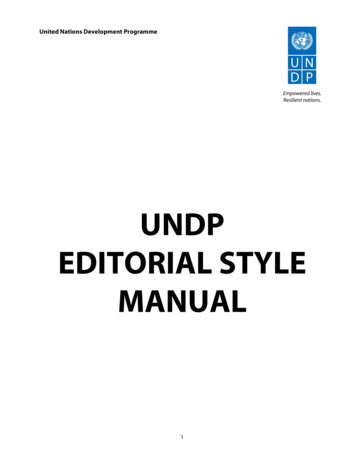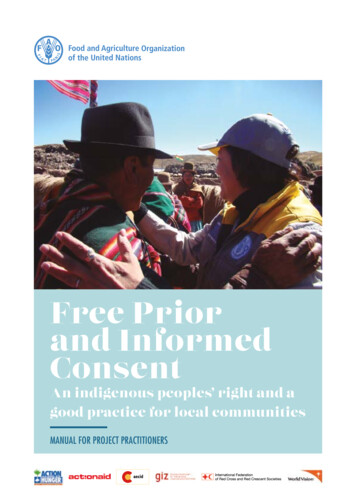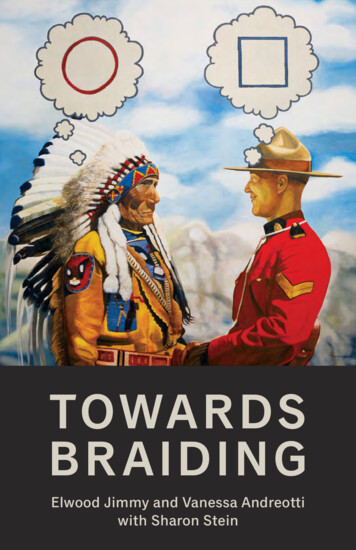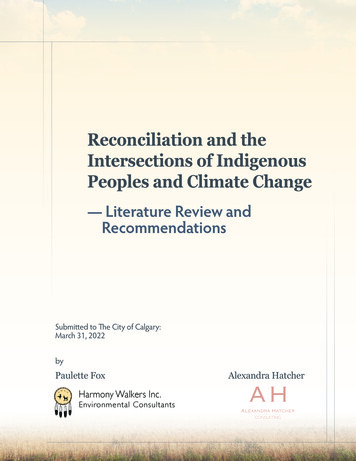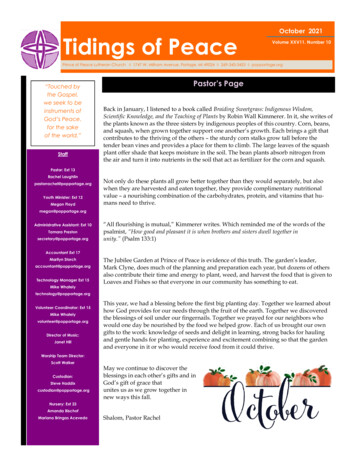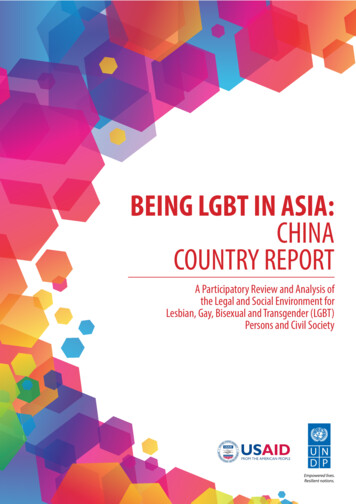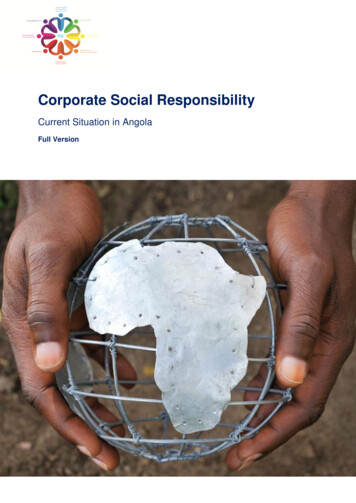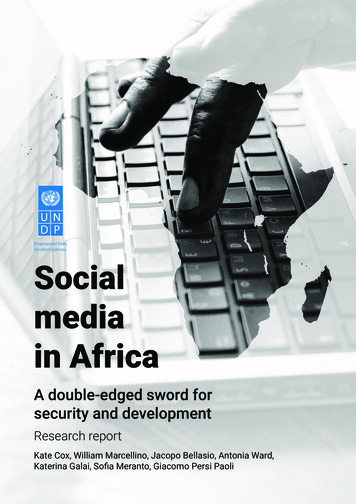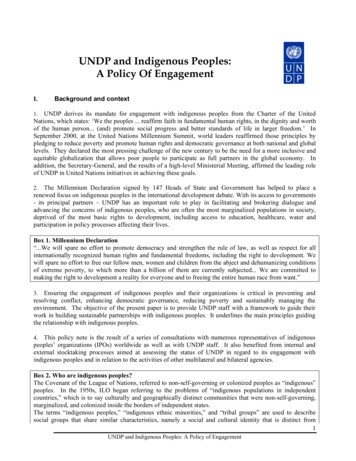
Transcription
UNDP and Indigenous Peoples:A Policy Of EngagementI.Background and contextUNDP derives its mandate for engagement with indigenous peoples from the Charter of the UnitedNations, which states: ‘We the peoples . reaffirm faith in fundamental human rights, in the dignity and worthof the human person. (and) promote social progress and better standards of life in larger freedom.’ InSeptember 2000, at the United Nations Millennium Summit, world leaders reaffirmed those principles bypledging to reduce poverty and promote human rights and democratic governance at both national and globallevels. They declared the most pressing challenge of the new century to be the need for a more inclusive andequitable globalization that allows poor people to participate as full partners in the global economy. Inaddition, the Secretary-General, and the results of a high-level Ministerial Meeting, affirmed the leading roleof UNDP in United Nations initiatives in achieving these goals.1.The Millennium Declaration signed by 147 Heads of State and Government has helped to place arenewed focus on indigenous peoples in the international development debate. With its access to governments- its principal partners – UNDP has an important role to play in facilitating and brokering dialogue andadvancing the concerns of indigenous peoples, who are often the most marginalized populations in society,deprived of the most basic rights to development, including access to education, healthcare, water andparticipation in policy processes affecting their lives.2.Box 1. Millennium Declaration“.We will spare no effort to promote democracy and strengthen the rule of law, as well as respect for allinternationally recognized human rights and fundamental freedoms, including the right to development. Wewill spare no effort to free our fellow men, women and children from the abject and dehumanizing conditionsof extreme poverty, to which more than a billion of them are currently subjected. We are committed tomaking the right to development a reality for everyone and to freeing the entire human race from want.”Ensuring the engagement of indigenous peoples and their organizations is critical in preventing andresolving conflict, enhancing democratic governance, reducing poverty and sustainably managing theenvironment. The objective of the present paper is to provide UNDP staff with a framework to guide theirwork in building sustainable partnerships with indigenous peoples. It underlines the main principles guidingthe relationship with indigenous peoples.3.This policy note is the result of a series of consultations with numerous representatives of indigenouspeoples’ organizations (IPOs) worldwide as well as with UNDP staff. It also benefited from internal andexternal stocktaking processes aimed at assessing the status of UNDP in regard to its engagement withindigenous peoples and in relation to the activities of other multilateral and bilateral agencies.4.Box 2. Who are indigenous peoples?The Covenant of the League of Nations, referred to non-self-governing or colonized peoples as “indigenous”peoples. In the 1950s, ILO began referring to the problems of “indigenous populations in independentcountries,” which is to say culturally and geographically distinct communities that were non-self-governing,marginalized, and colonized inside the borders of independent states.The terms “indigenous peoples,” “indigenous ethnic minorities,” and “tribal groups” are used to describesocial groups that share similar characteristics, namely a social and cultural identity that is distinct from1UNDP and Indigenous Peoples: A Policy of Engagement
dominant groups in society. United Nations human rights bodies, ILO, the World Bank and international lawapply four criteria to distinguish indigenous peoples:(a) indigenous peoples usually live within (or maintain attachments to) geographically distinct ancestralterritories; (b) they tend to maintain distinct social, economic, and political institutions within their territories;(c) they typically aspire to remain distinct culturally, geographically and institutionally rather than assimilatefully into national society; and (d) they self-identify as indigenous or tribal.Despite common characteristics, there does not exist any single accepted definition of indigenous peoples thatcaptures their diversity as peoples. Self-identification as indigenous or tribal is usually regarded as afundamental criterion for determining whether groups are indigenous or tribal, sometimes in combinationwith other variables such as “language spoken,” and “geographic location or concentration.”II. Why engage with indigenous peoples?5. The rationale for UNDP engagement with indigenous peoples and their organizations is grounded inUNDP’s mandated areas of work; processes and agreements of development cooperation; and the aspirationsof indigenous peoples.Poverty reduction. Human poverty is often deeper and more extensive among indigenous peoples.They are a distinct group among the poor and are often excluded from decision-making processes andmarginalized by development. It is important to note that indigenous peoples are often categorized as poor;however, they do not regard the term as appropriate since they consider themselves rich in knowledge andculture. Historically, indigenous peoples have often failed to benefit from economic and social development,including many projects supported by international agencies, some of which have had a negative effect.Indigenous peoples have been typically subjected to distinct, persistent, and often violent forms ofdiscrimination. It is for this reason that the international community has considered it necessary to adoptspecial legal measures to protect the rights and ensure the inclusion and participation of indigenous peoples.6.Human rights. The present policy is informed and underpinned by the international human rightsframework and the UNDP policy paper entitled Integrating Human Rights with Sustainable HumanDevelopment (1998) that sets the legal framework and guiding principles for engagement with indigenouspeoples, in addition to the international conventions, declarations and programmes of action that recognizeindigenous peoples’ rights, and their vital role in development and environmental management. Furthermore,the Memorandum of Understanding (MOU) between UNDP and the Office of the United Nations HighCommissioner for Human Rights (UNHCHR) signed 14 March 1998 stresses the importance of working inpartnership towards the advancement of the goals of the International Decade of the World’s IndigenousPeople and the Third International Decade against Racism.7.8. Democratic governance. At the Millennium Summit, Governments agreed “to work collectively formore inclusive political processes, allowing genuine participation by all citizens in all countries. and tostrengthen the capacity of all our countries to implement the principles and practices of democracy andrespect for human rights.” In light of this, the inclusion of indigenous peoples - no matter how small thepopulation - is integral to adopting democratic principles of participation. In countries where indigenouspeoples make up the majority or a significant percentage of the total population, they are a criticalconstituency to realizing multi-stakeholder trust. Therefore, building national capacities for democraticconsensus-making and civil society organizing provides a crucial and urgent opportunity for the inclusion ofhistorically poor, marginalized and vulnerable indigenous communities in power-sharing and decisionmaking.Globalization. Although information and communication technology has linked indigenous peoplesworldwide and has been an important factor in the emergence of a global indigenous movement, the benefits9.2UNDP and Indigenous Peoples: A Policy of Engagement
of globalization have been spread unequally, with many still left excluded. Recent developments havesometimes impoverished and marginalized indigenous peoples both in conventional income terms and fromtheir own cultural perspectives. Not only are indigenous territories under growing pressure for the extractionof natural resources, but indigenous communities that try to continue living on their ancestral lands bytraditional means find themselves increasingly suffering from competition with large-scale public and/orprivate industrial interests.10. Indigenous peoples are often unable to take advantage of their most distinctive asset, their localknowledge, at the same time that it is increasingly being commercialized by international enterprises underthe protection of a global patent regime - the Trade Related Aspects of Intellectual Property RightsAgreement, otherwise known as the TRIPS Agreement.11. Indigenous knowledge. Indigenous peoples number over 300 million, and represent over 4000languages and cultures. Indigenous cultures comprise a heritage of diverse knowledge and ideas that is aresource for the whole world. As UNDP pursues sustainable human development, attention has been placedon indigenous peoples largely owing to their sustainable development practices. This has led to an interest inindigenous peoples’ ways of life, their cultures, sciences, land and resource management, governance,political and justice systems, knowledge and healing practices. Recognition of indigenous peoples’ assetsand traditional knowledge (such as terrestrial and marine ecosystems, naturally occurring medicines fromplants and insects, cultivated plant varieties, and animal husbandry) can be helpful to national andinternational development. Furthermore, indigenous peoples’ continued existence is a testimony to thesustainability and viability of indigenous economic production systems, and social and governance practicesthat should be supported and enhanced, and most importantly, incorporated into mainstream developmentpractices.12. International and national processes. In its Decision 1992/255, the Economic and Social Councildirected UNDP and other United Nations operational bodies and specialized agencies to respect the rights ofindigenous peoples. The essential linkage between indigenous peoples’ rights and successful humandevelopment was further emphasized when the General Assembly, in its resolution 50/157, invited UnitedNations organizations to give increased priority and resources to improving the conditions of indigenouspeoples, through the preparation of specific programmes of action for the implementation of the goals of theInternational Decade of the World’s Indigenous People (1995-2004).13. The distinct legal status and rights of indigenous peoples have been recognized at each of the worldconferences since the 1992 United Nations Conference on Environment and Development (UNCED). Agrowing number of international legal instruments recognize indigenous peoples as a particularly importantgroup for achieving sustainable development. For example, ILO, in particular, has been at the forefront ofdefending the social and economic rights of such groups as well as setting and implementing internationalstandards to ensure the protection of their rights. The ILO Convention on Indigenous and Tribal Peoples,1989 (No.169) states indigenous peoples have the right to decide their own priorities for development and toexercise control over and participate in the process of development; the Convention on Biological Diversity(CBD) refers repeatedly to indigenous and local communities and their role in the conservation ofbiodiversity and the environment. Not only do several conventions highlight the centrality of land, theprotection and maintenance of local knowledge systems, and local decision-making to the enjoyment ofindigenous peoples’ human rights and their right to development, they also provide the legal tools fornegotiation and effective dialogue at the national level.14. The United Nations has recently established the Permanent Forum on Indigenous Issues (authorized byEconomic and Social Council resolution 2000/22 28 July 2000). It will serve as an advisory body to theCouncil with a mandate to discuss issues relating to indigenous peoples, including economic and socialdevelopment, culture, the environment, education, health and human rights. The Forum will provide expert3UNDP and Indigenous Peoples: A Policy of Engagement
advice and recommendations to the Council as well as to United Nations specialized agencies, funds andprogrammes.Box 3. Special rapporteur on the situation of human rights and fundamental freedoms of indigenouspeoples At its 57th session, the Commission on Human Rights adopted two relevant resolutions. By itsresolution 57, the Commission appointed a special rapporteur with the mandate to gather and exchangerelevant information. In addition to requesting that indigenous issues be discussed at the upcoming WorldConference against Racism, Discrimination, Xenophobia and Related Intolerance, through its resolution 59the Commission urged similar discussion and consideration at the special session of the General Assembly forthe follow-up to the World Summit for Children and the World Summit on Sustainable Development.15. Increasingly, Governments have recognized the rights of indigenous peoples in their constitutions - inmany Latin American countries for example; in national legislation, as is the case of the Philippines with theIndigenous Peoples’ Rights Act; and in peace agreements. As of the end of July 2001, a total of 14governments have also ratified the ILO Convention on Indigenous and Tribal Peoples, 1989 (No. 169).Indigenous issues for UNDP support16. In the UNDP consultation process, representatives from IPOs identified the following areas for UNDPsupport.1. Participation. Indigenous peoples seek participation and representation at all levels in decisionmaking processes, especially those that may affect their human, developmental and environmental rights.2. Self-determination. Indigenous peoples look for assistance in the recognition of the right to selfdetermination as defined in the United Nations International Covenants on Civil and Political Rights andEconomic, Social and Cultural Rights. By virtue of that right, they freely "determine their political statusand freely pursue their economic, social and cultural development.” As clearly expressed in the 1970Declaration on Principles of International Law concerning Friendly Relations and Cooperation amongStates in accordance with the Charter of the United Nations and the United Nations Draft Declaration ofthe Rights of Indigenous Peoples, self-determination shall not be construed as authorizing or encouragingany action that would impair the territorial integrity or political unity of sovereign and independent states.3.Conflict prevention and peace-building. Indigenous peoples seek UNDP support in conflictprevention and peace-building strategies in addition to assisting in the rehabilitation and reintegration ofdisplaced peoples.4.Environment and sustainable development. Many indigenous peoples seek the recognition,support and development of sustainable communities based on their own cosmovision - a balancebetween land, nature, people and spirit.5.Globalization. In addressing globalization, indigenous peoples urged that UNDP examine its effectson the livelihoods of indigenous peoples, especially with regard to food security, security of tenure,gender equity, intellectual and cultural property rights, and indigenous knowledge.III. Lessons learned17. UNDP engagement with indigenous peoples at the country level has been extensive. Many of UNDPcountry, regional and global programmes - small grants programmes in particular - have involved indigenouspeoples and their organizations. These initiatives have focused on poverty eradication, environmentalconservation, dryland development, conflict prevention and resolution, and cultural revitalization. UNDP hassupported innovative projects under the Indigenous Knowledge Programme (IKP), whose main objective was4UNDP and Indigenous Peoples: A Policy of Engagement
to promote indigenous knowledge through targeted capacity-building, and direct support for projectsformulated and implemented by indigenous peoples and their organizations.18. Some findings indicate that projects based on a development strategy formulated by indigenous peoplesand true to the traditional indigenous customs and values tend to be successful, as demonstrated in the UNDPsponsored IKP Project for the Recuperation and Development of Indigenous Knowledge for the Conservationof Ecosystems and Biodiversity in the Amazon Forest of Yana Yacu in Ecuador. Not only is indigenousknowledge conserved and developed, it also lays the basis for the sustainable livelihood of the community.19. Evaluations have pointed out that programmes and projects should focus on building regional, nationaland local networks for exchange of experiences and information as well as for policy lobbying on issuesaffecting indigenous peoples such as the patenting of indigenous cultural knowledge. This often leads toincreased awareness, interest and understanding of the communities in a number of areas, such as theprotection of culture and indigenous knowledge systems; potential for further projects and activities;establishment of relationships with government and other organizations; and greater flows of informationexchange and awareness about information sources.20. Small grants programmes for community initiatives have been welcomed as an appropriate way ofstrengthening local capacity. The implementation of a well-prepared project within a broader perspective andbased on indigenous values and visions can have an enormous beneficial impact at the community level.Box 4. UNDP/Global Environment Facility (GEF) Small Grants Programme (SGP)UNDP GEF/SGP has supported over 300 projects involving indigenous peoples. Indigenous peoples andtheir organizations are GEF/SGP major partners in a wide range of activities including the revival of the useof traditional medicinal plants and sustainable agricultural knowledge practices and systems. The GEF/SGPdraws on indigenous peoples’ expertise in undertaking environmental surveys; facilitating dialogue with localand central government; and institutional and legal capacity building.21. Regional programmes such as the Highland Peoples Programme (HPP) in South East Asia have proven tofill a particular niche and enjoy a comparative advantage. Most notably in promoting regional integration,agreements and standards through the facilitation of regional dialogue among Governments; introducing ordemonstrating policy options in a regional “safe space” that can be discussed for adoption, where relevant, atcountry level; and in fostering partnerships, networking and institution-building across a region alongcommon agendas, among national and international partners, including State and non-State actors. The HPPalso identified the challenge of translating local demands to national and regional policies.Box 5. Local realities and policy reform: bridging the gapUNDP engagement with indigenous peoples and their organizations has demonstrated the effectiveness ofbuilding policy from below, and successfully bridging grass-roots activities with policy reforms. In thePhilippines, after the enactment of the 1997 Indigenous Peoples’ Rights Act (IPRA), local feuds over landownership broke out among residents in ancestral domain areas of the Cordillera region. Women, usingindigenous knowledge systems, emerged as leaders in settling these disputes, forming the Women’s Networkfor Peace and Development. Together with this network, UNDP helped to train women volunteers to leadcommunity groups, as well as local government units to prepare development plans for their ancestraldomains. The volunteers played a lead role in mapping boundaries and fostering peace pacts amongcommunities.22. A particular strength that emerges is the UNDP capacity to facilitate and broker sensitive dialogueinvolving the State, civil society organizations (CSOs) and indigenous peoples and their organizations. To5UNDP and Indigenous Peoples: A Policy of Engagement
partner more effectively with indigenous peoples, UNDP needs to develop its capacity to engage indigenouspeoples’ full participation in its programme and project design and implementation. Building anunderstanding of indigenous peoples’ development perspectives and developing cultural sensitivity is crucialif UNDP is to avoid the common pitfall of paternalistic, “top-down” approaches to programmes involvingindigenous peoples.23. These gaps can be addressed through training, sensitization and capacity-building of UNDP staff, non-governmental organizations and local and regional government officials. The capacity of governmentstructures to coordinate, monitor, support and make policy in regards to its engagement with indigenouspeoples is needed for sustainable development to take place. Meaningful consultation with indigenouspeoples, their organizations and communities in programme and project design and implementation is,indeed, essential. Improving coordination with other United Nations organizations, perhaps through theUnited Nations Development Assistance Framework (UNDAF), could serve to increase the effectiveness andrelevance of development support for indigenous peoples.The UNDP niche24. UNDP’s coordinating role at the country level, its human development paradigm, advocacy of democraticgovernance, and policy of mainstreaming human rights positions makes it a key partner for pursuing a moreholistic approach to development. Moreover, UNDP’s country presence and the relationship of trust it haswith governments and civil society partners enables UNDP to play a unique role in bringing together differentstakeholders in development processes. This mandate can serve as a critical entry point and foundation forsupporting more inclusive development policies and programmes; brokering dialogues with all actors;facilitating participatory approaches; and creating the political space for alternative views to be shared.Box 6. Guatemala: creating an enabling environmentCSOs and indigenous peoples and their organizations played an active role in negotiating peace by promotinginformal linkages among the opposing parties, by helping to define the major issues and build consensus.UNDP supported the establishment of the Civil Society Assembly charged with discussion of the substantialissues, formulation of specific proposals based on consensus, and review of the peace agreements. UNDPensured that space was created so that the perspectives of indigenous peoples and their organizations werebrought to national attention. The Assembly helped to overcome distrust, promote broad participation andmove the country away from confrontation.IV.Principal objectives for effective partnerships25. There are two overall objectives of UNDP engagement with indigenous peoples and their organizations.1. To foster an enabling environment that: promotes indigenous peoples’ participation in alldecision-making levels; ensures the co-existence of their economic, cultural, and socio-politicalsystems with others; and develops the capacity of Governments to build more inclusive policiesand programmes; and2. To integrate indigenous peoples' perspectives and concepts of development into UNDP work.V.Priority areas of engagement26. In recognition of indigenous peoples’ needs, aspirations, and rights, and across the range of possible areasfor partnering, four thematic areas are set out below. They include basic principles and suggested issues to beaddressed in programmes of work.6UNDP and Indigenous Peoples: A Policy of Engagement
A. Democratic governance and human rightsParticipation27. By incorporating the “right to development” in its work, UNDP fosters the full participation ofindigenous peoples in its development processes and the incorporation of indigenous perspectives indevelopment planning and decision-making. This right is of particular significance to indigenous peoplesbecause in their experience, development has tended to be imposed upon their communities from outside,often resulting in violations of their “right to development,” by damaging ancestral lands, water and naturalresources.28. Consistent with United Nations conventions such as ILO Convention 169, UNDP promotes and supportsthe right of indigenous peoples to free, prior informed consent with regard to development planning andprogramming that may affect them.Human rights29. Through its human rights approach to development and governance, and working together withGovernments, CSOs and IPOs, UNDP promotes the recognition of indigenous rights to lands, territories andresources; laws protecting indigenous lands; and the inclusion of indigenous peoples in key legislativeprocesses. As embedded in the Charter of the United Nations and in international law, these activities will inno way threaten the preservation of the security and territorial integrity of States.30. The UNDP Human Rights Policy recognizes the rights of distinct peoples living in distinct regions toself-determined development and control of ancestral lands. This embraces a concept of development thatincorporates indigenous peoples’ own aspirations, spirituality, culture, social and economic aims.Box 7. GEF/SGP Biodiversity programme for the Aytas of Zambales, PhilippinesThis project aimed at conserving biodiversity, rehabilitating the forest ecosystem, and securing ancestraldomain. One of the major outputs of the project was to institutionalize the ancestral domain claim of theAytas through the issuance of the Certificate of Ancestral Domain Claim (CADC). The CADC represents amajor step towards sustainable ancestral domain management by the Aytas.Globalization31. The United Nations Millennium Declaration calls for fully inclusive and equitable globalization, in whichrespect for human rights and fundamental freedoms are given utmost importance. To respond to this callpositively, the governance of globalization should be geared towards inclusion, equality and equity,especially in the arena of international trade.32. Existing rules regulating intellectual property rights at the global level are not conducive to theparticipation of indigenous peoples in the national or global economy. Current patent laws, for example, donot recognize traditional knowledge and systems of ownership. They ignore the cultural diversity inherent incustomary practices of sharing innovations as well as the diversity of opinion on what can and should beowned. The patent regime, under the TRIPs agreement, renders the accumulated knowledge of indigenouspeoples especially vulnerable to the interests of biotechnology companies.33. There is growing recognition of the need to protect indigenous knowledge systems. The 1992 CBDrecognizes the need to protect property rights as well as the need for companies to obtain prior informedconsent before doing research. But the Convention cannot be legally binding unless translated into nationallaw – and indigenous communities seldom receive priority attention or protection under national law.7UNDP and Indigenous Peoples: A Policy of Engagement
34. UNDP has an important role to play in fostering open debate across countries that supports indigenouspeoples’ interests and makes available the most relevant and updated information for use by negotiators andpolicy-makers. Such debate should consider collective rights to knowledge and resources, the need for priorinformed consent for their use – consent not just of Governments, but indigenous communities – and the needfor transparency in research outcomes. Guidelines for legal recognition of intellectual property sought byindigenous peoples and their organizations are needed.B. Poverty reduction35. The debilitating incidence of human poverty in most indigenous communities is probably the most visibleevidence of exclusion (unequal access to productive resources and basic social services) if not discrimination.In order to tackle issues with respect to ownership and use of land and natural resources, including safedrinking water; issues relating to education and health; protection of cultural and intellectual property; andparticipation in formal decision-making processes, a focus on poverty-reduction strategies that includeindigenous peoples is vital.36. UNDP is committed to incorporating the concerns of indigenous peoples into UNDP approaches topoverty reduction at the macro level through participation and inclusion in poverty- reduction strategies andaction plans as well as at the local level by empowering indigenous peoples and their organizations tonetwork and influence policy. In addition, UNDP works with Governments to ensure that indigenous peoplesare included and consulted in poverty-reduction strategies and processes.C. Conflict prevention and peace-building37. In harmony with its strategy paper, the role of UNDP in crisis and post-conflict situations (DP/2001/14),UNDP will seek to better understand the underlying causes of conflict (e.g. social exclusion, control overresources and resource use, violation of rights, including cultural and linguistic, discrimination, inequality,and citizenship) engage in conflict-prevention strategies; facilitate conflict resolution and peace-building(when invited to do so); and assist in the rehabilitation and reintegration of returnees and war-affectedpeoples.38. As advised by the Civil Society Advisory Committee, UNDP has a role to play in legitimizing thepresence and role of indigenous peoples and their organizations in preventing conflict and promoting peace,especially with national institutions of the State; in the monitoring of peace agreements, especially thoseinvolving indigenous peoples (only as requested by Governments or the Security Council); and in exploringalternatives to coca cultivation and transformative initiatives that promo
historically poor, marginalized and vulnerable indigenous communities in power-sharing and decision-making. 9. Globalization. Although information and communication technology has linked indigenous peoples worldwide and has been an important factor in the emergence of a global indigenous movement, the benefits 2

